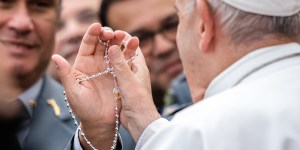Lenten Campaign 2025
This content is free of charge, as are all our articles.
Support us with a donation that is tax-deductible and enable us to continue to reach millions of readers.
See below to follow the list of the Shrines.
Watch the Rosary live at 6 p.m. Rome time (12 noon EDT) by clicking here. The video screen at the top will go live at the designated time.
Day 22 intention: For all volunteers
For today's Rosary Relay, we turn to a devotion to Mary in a picturesque Benedictine monastery in the mountains of Spain.
According to legend, the image of Our Lady of Montserrat was found in the year 880, when one Saturday evening, shepherds saw a light come down from heaven, and a beautiful melody filled the air.
For the following four Saturdays, the shepherd children -- first accompanied by their parents and then also by religious leaders -- saw the same vision. The bishop, from Manresa, came to investigate.
They entered a cave, where they found the statue. The bishop planned to bring the statue to be venerated in Manresa, but as soon as they lifted her from the cave, the image became so heavy that it couldn't be moved. The bishop took this as a sign that the Virgin Mary wanted a shrine built to her in this area.
Her feast is April 27.
The image is some 38 inches tall. It depicts Our Lady seated on a throne with the Christ Child on her lap. In Mary's right hand is an orb, representing the universe. Her left hand is poised over the Child's shoulder, as if to indicate that He is the king.
The Child has his right hand raised in blessing, and in his left, he holds a pineapple, a symbol of eternal life and fruitfulness.
The face and hands of the Virgin are black, making this image one of the various "Black Madonnas" found around the world. Several are in Spain. One of the most well known is Our Lady of Czestochowa in Poland.
Four chapels on the site, possibly used by hermits, can be traced back to the 9th century.
Benedictine monks have inhabited the monastery of Montserrat since 1025.
At the monastery, there is a boys' choir, the Escolania, one of the oldest boys' choirs in all of Europe.










